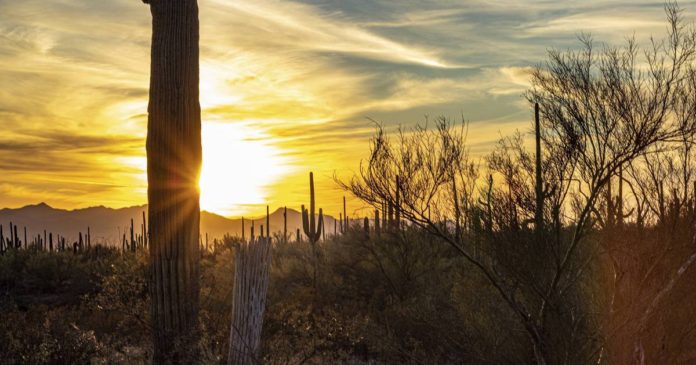“Next up is the team from Chicago,” crackles the disembodied voice over the speaker system mounted above the arena.
A genuine “Yee-haw!” is heard across the dusty corral, as two men and a woman ride hard out of the gate, heading toward the small herd of bored cattle at the far end of the space. Dust flies from horses’ hoofs, people shout cheers and wave hats, and the trio targets a calf at the side and cuts off the young cow from its siblings, working it toward the chute.
The calf picks up its pace as two of the riders urge it from one side, and their third partner from the other. As it trots into the chute, an air horn blows. Cheers resonate from waiting riders and a sparse group of onlookers in the stands.
“Eighteen seconds,” the announcer marvels. “That’s just two seconds off from the guest rodeo record.”
Paul Janicki, an Evanston architect; Ian Janicki, his entrepreneur son from Chicago but now based in Los Angeles; and Sonya Major, a Rogers Park singer, are all part of a family that heads to Tucson, Arizona, every fall to live like cowboys at White Stallion Ranch, a dude ranch out in the Sonoran Desert.
At this point, they’re basically pros.
“We scoped out the cattle, and made our strategy,” Paul Janicki says. They’ve had plenty of training. “We’ve been coming out here as a family for 25 years.”
“Here” is White Stallion Ranch (whitestallion.com), one of many dude ranches that populate the American West. This isn’t the experience of “City Slickers,” the 1991 Billy Crystal movie about a group of New Yorkers entangled in cattle drive misadventures, but a more civilized ranching experience of Western activities.
It’s a tradition that started in the 1890s in North Dakota. “Dude” referred to folks from back east who paid for the romanticized experience of Western life.
“You can’t go chasing cows on horses in Chicago,” Major says. “(White Stallion Ranch) is my favorite place.”
The Janicki clan clusters across four dining tables pulled together under gentle lighting as the sun paints the sky from yellow to purple. Surrounded by giant saguaro and organ pipe cactuses, the dinner scene looks just like a family reunion in a John Wayne Western.
Back in Chicago, the temperature hits 37 in the afternoon. In the growing Arizona darkness, the March temperature is still over 70 degrees. Paul Janicki, looking around, notes, “It’s a change of pace from Chicago weather.”
:quality(70)/cloudfront-us-east-1.images.arcpublishing.com/tronc/ZBIFSWHZSNF3NJPICOFYI3DH3U.jpg)
:quality(70)/cloudfront-us-east-1.images.arcpublishing.com/tronc/M77H35ARTVH4JARV3IWMLDLLYA)
White Stallion is a hybrid of a working ranch, with cattle operations separate from the resort, and the visitor area designed and decorated like a traditional southwestern ranch. It looks rustic on the outside, with low-slung Mexican-style casitas, or cabins, but inside, the spacious rooms and modern bathrooms are what’s expected from a top-flight hotel.
“You could say that there are three types of dude or guest ranches,” says Jamie Denue, administrator for the Dude Ranchers Association (duderanch.org), a Cody, Wyoming-based group of 92 all-inclusive ranches. “There are the luxury ranches that are essentially top-tier resorts with Western activities like horseback riding; the traditional guest ranches, ranging from rustic to high-end; and working ranches where you saddle up with the ranching crews.”
The dude ranch, the traditional term, is now synonymous with the guest ranch, but there are a vast range of experiences. Many are all-inclusive and provide a real-life family experience for less than the cost of a week at Disneyland. Some offer such lofty lodgings of four- and five-star magnitude (with prices to match) that they’re largely left to celebrities and one-percenters.
“We like to tell people ‘yes,’” says Patrick McVey, assistant general manager at Lone Mountain Ranch (lonemountainranch.com) in Big Sky, Montana. “We want people to have a good time, and we will make the effort to accommodate just about any request.”
Lone Mountain has more employees than guests. It is a dedicated guest ranch on 148 acres of pine forest, with a fork of the Gallatin River cascading between the cabins. Where the White Stallion offers all its activities on the ranch proper, Lone Mountain mixes on- and off-site activities because of its proximity to Yellowstone National Park (nps.gov/yell) and access to the adjoining lands of the Gallatin National Forest (fs.usda.gov/main/custergallatin). Guests stay in log cabins complete with porch rockers, rustic decor and a modern hybrid Western-art deco bathroom. Cabins have no phones or televisions, but there is cell service and high-speed Wi-Fi.
“We want our guests to disconnect as much as possible,” McVey says.
:quality(70)/cloudfront-us-east-1.images.arcpublishing.com/tronc/RZX6L27FNRHNLNNDDPYXC2TBA4.jpg)
At White Stallion, the included meals are served chuck-wagon style to ranch guests in the dining hall or on the broad stone patio. Lone Mountain includes meals in guest packages with fine restaurant service, but its dining hall and historic saloon are among the top restaurants in southern Montana. The menu, featuring bison Wellington and local trout, attracts diners from as far as Bozeman and West Yellowstone.
While both White Stallion and Lone Mountain have activities and events for children, Majestic Ranch (majesticduderanch.com) down the highway from Mesa Verde National Park in Mancos, Colorado, is focused on families as the heart of its business. It has adult activities, plus a staff of certified counselors for managing children’s time.
All the ranches offer horseback riding and maintain herds large enough to assign a specific horse to each guest for the duration of their stay. This allows rider and horse to become familiar with each other and makes for a better experience on the trail. Trail rides encircle nearby lakes or head off into the mountains or desert for all-day rides or overnight pack trips.
Lone Mountain has age-appropriate activities for children and maintains a staff of trained camp counselors to help with learning to ride a horse, archery, roping and kayaking. White Stallion has similar options, including camp counselors and a kids’ rodeo.
Majestic Ranch centers its activities on the family, from the included meals to a weekly kids-versus-parents baseball game. (The kids have never lost.) There are adult activities, and camp counselors keep children busy while parents indulge. Both Majestic and White Stallion have large children’s playgrounds.
:quality(70)/cloudfront-us-east-1.images.arcpublishing.com/tronc/KAVHO6LWGNHRXNQGVMKXR3PJ3A.jpg)
Activities start early at a dude ranch, usually right after breakfast. At Majestic, one of the trail rides heads out as soon as dishes arecleared. Lunch is on the trail, and riders head into the mountains on backcountry roads. The ranch also offers trips into the national forest on ATVs, for those not ready for eight hours in a saddle.
On the luxury side, the spa experience is as much a part of the ranches as is a morning ride. The Ranch at Rock Creek (theranchatrockcreek.com) in Philipsburg, Montana, carries a five-star Forbes rating. In Tuscon, Tanque Verde Ranch (tanqueverderanch.com) was Condé Nast’s 2021 Readers’ Choice Top Southwest Resort. They, too, are all-inclusive vacations. Tanque Verde boasts a history extending to 1868 and bills itself as “the last luxurious outpost of the Old West.”
Getting a reservation takes planning, and Denue recommends scheduling the trip a year in advance.
“As many as 75% of the guests at a dude ranch are repeat visitors,” she says. “Some of the ranches wait until previous guests are booked before opening reservations to new visitors.”
The main purpose of the Dude Ranchers Association, she says, is to help guests find a ranch with activities to match personal interests, prices to fit the budget and an ideal location.
Various ranches offer a host of activities that are similar but tailored to the area. White Stallion has a breakfast ride where guests meander through the desert for about a half-hour on the way to an outpost set up for shady chuck-wagon breakfasts. At Lone Mountain, guests can ride in a horse-drawn wagon or ride horses to an isolated mountain logging cabin with a historic wood-fired stove.
“The cabin was built around the stove,” McVey says with pride.
White Stallion and Majestic have most activities based on or originating from the ranch. Lone Mountain uses vetted guides and transports visitors to canoe and kayak on Hebgen Lake on the Madison River or fly-fishing on one of the nearby Montana rivers. Ranches close to national parks offer half- and full-day trips from the ranch.
Guests often wander off the ranch on their own to visit nearby attractions. The activities offered at the various ranches can easily fill entire days, so it’s up to guests to decide whether to book their days solid, or include some down time.
“Everybody’s family should have a dude ranch experience,” says Chicago’s Major. “Riding a horse into the desert with no signs of modern civilization — it’s an experience that sticks with you. Staying at a ranch like this is something you’ll remember forever.”
The Dude Ranchers Association
P.O. Box 2307, Cody, Wyoming; 307-587-2339; duderanch.org
White Stallion Ranch
9251 W. Twin Peaks Road, Tucson, Arizona; 520-297-0252; whitestallion.com
Lone Mountain Ranch
750 Lone Mountain Ranch Road, Big Sky, Montana; 800-514-4644; lonemountainranch.com
Majestic Dude Ranch
42688 Road N, Mancos, Colorado; 970-533-7900; majesticduderanch.com
Tanque Verde Ranch
14301 E. Speedway Blvd., Tucson, Arizona; 520-296-6275; tanqueverderanch.com
The Ranch at Rock Creek
79 Carriage House Lane, Phillipsburg, Montana; 877-786-1545; theranchatrockcreek.com
Saguaro National Park, Arizona: nps.gov/sagu
Mesa Verde National Park, Colorado: nps.gov/meve
Yellowstone National Park, Wyoming-Montana: nps.gov/yell
Gallatin National Forest, Montana: fs.usda.gov/main/custergallatin
San Juan National Forest, Colorado: fs.usda.gov/sanjuan
Credit: Source link






























